Unlike my herpetologist mates Steve Wilson and Rod Hobson, I’ve spent little time wandering the remote parts of the scrub tracking down rare and elusive members of that wonderful family Varanidae — the monitors or goannas. Unlike those gents, I have never grappled with the elusive green Emerald Monitor (Varanus prasinus) from Moa Island in the Torres Strait, or scruffled about in the sharp spinifex chasing the tiny but beautful Short-tailed Pygmy Monitor (Varanus brevicauda).
One goanna I have been chasing, and trying to photograph live for years (well, at times, not constantly) is the Freckled Monitor (Varanus tristus). With a total length of only 76cm, and a striking pattern of dark-centred circles, it’s a reptile I’ve been hoping to get an image of. So, in typical Ashdown fashion, with both Steve and Rod in the car, I managed to actually run over one and kill it just outside Barakula State Forest. You can imagine how I felt gazing at this stunning, but very dead, reptile while my ever-supportive colleagues bombarded me with a relentless torrent of abuse for my woeful lack of ability to swerve around reptiles without rolling the car.
Skip ahead to Isla Gorge National Park this year, on the last stage of a long day’s walk with mates James Hunt, Rob Mancini and son Harry. I’m tired and way behind. Rob calls out, “Ashdown, there’s an interesting goanna here.” Another lace monitor, I think wearily . “Is it big or small?” “Small, and interesting,” comes Rob’s reply. I wander down and am stunned to see a spectacular Freckled Monitor on a tree right next to Rob. “Nobody move!” I shout like some demented bushranger and stagger about trying to haul the camera out of the bag. My luck holds and I finally get some shots of this exquisite reptile — alive and breathing, even better. Thanks heaps, Mancini.
Here are some shots of a couple of other monitors I’ve had the good luck to encounter. How can anyone get enough of these wonderfully intelligent and diverse reptiles?
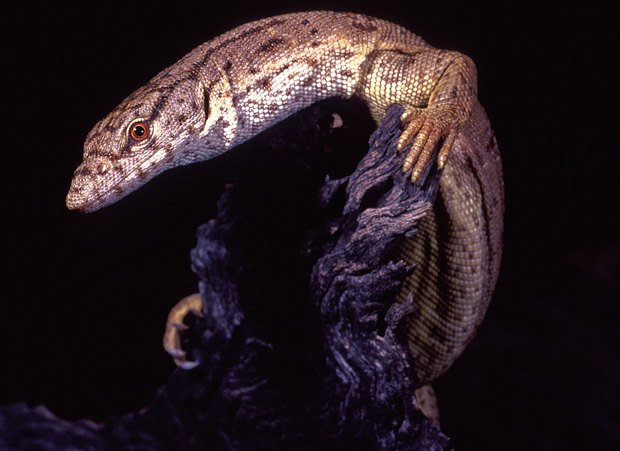
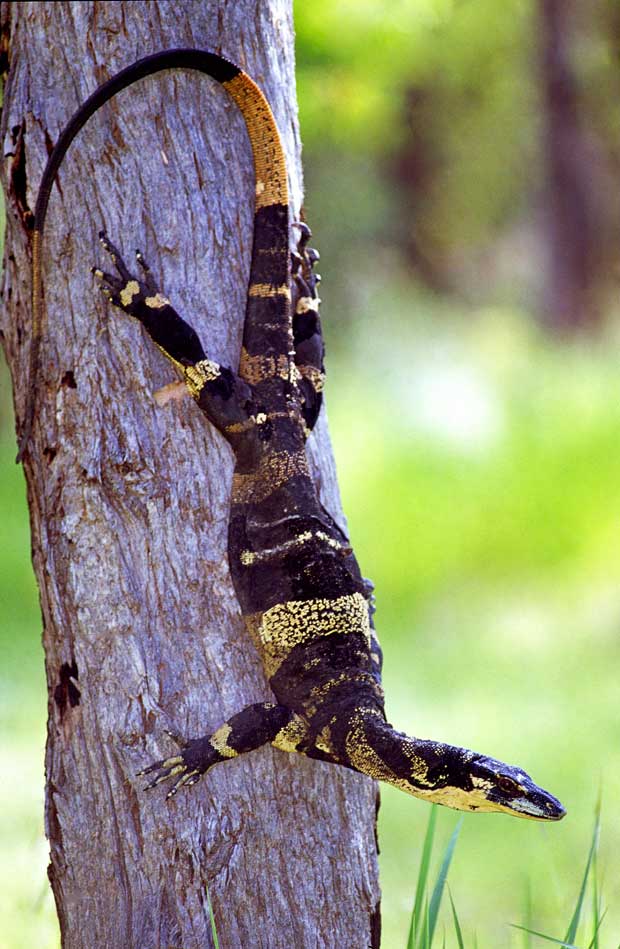
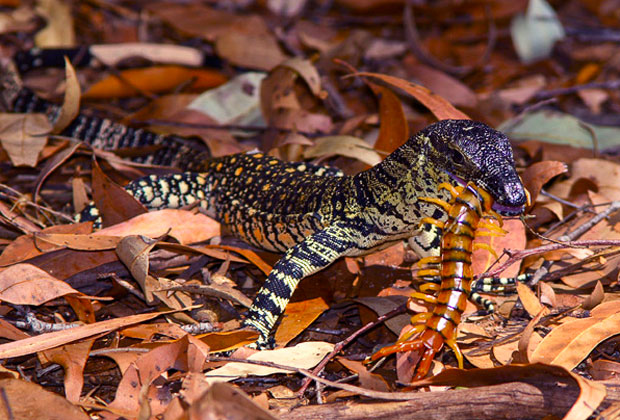
Very young Lace Monitor eating a centipede, Lake Freshwater, Cooloola National Park. Photo by Steve Wilson (my pics of this lizard were ordinary).
For many great shots of monitors, and other reptiles, check out Steve’s two field guides to Australian reptiles. Available at bookshops and online at Andrew Isles.

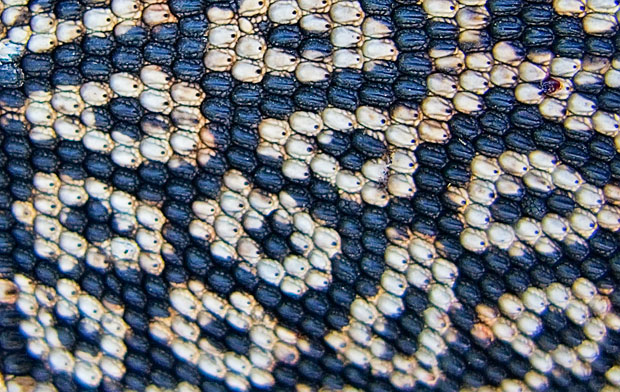
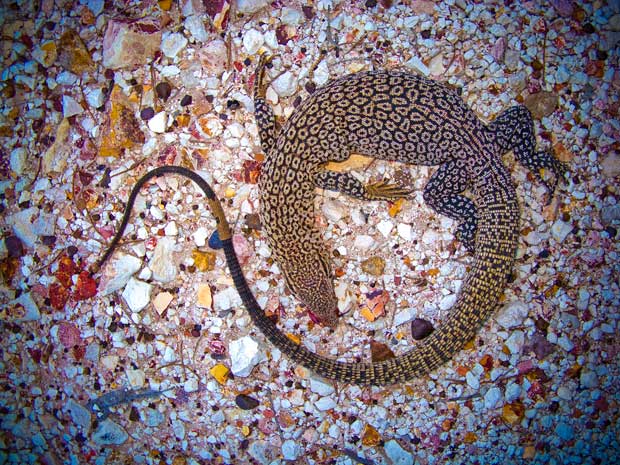
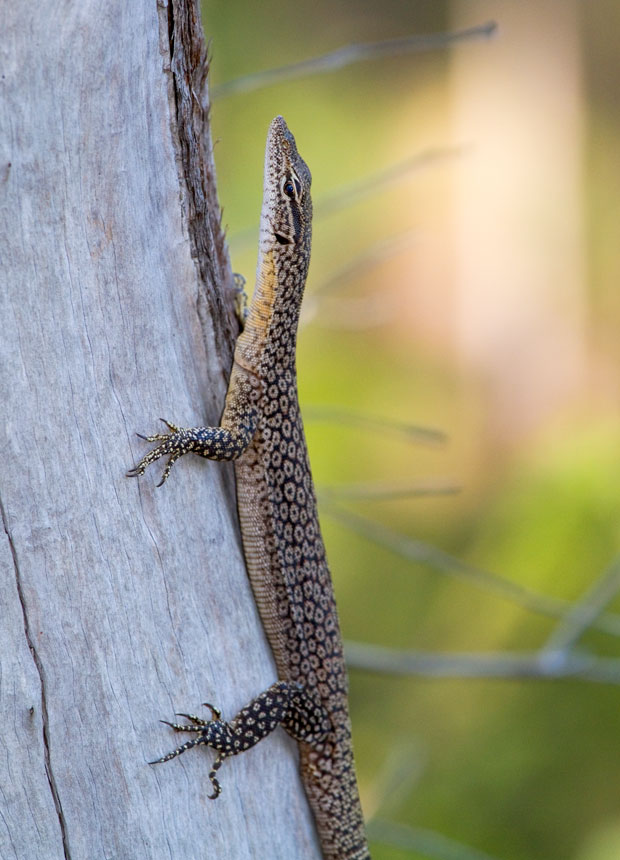
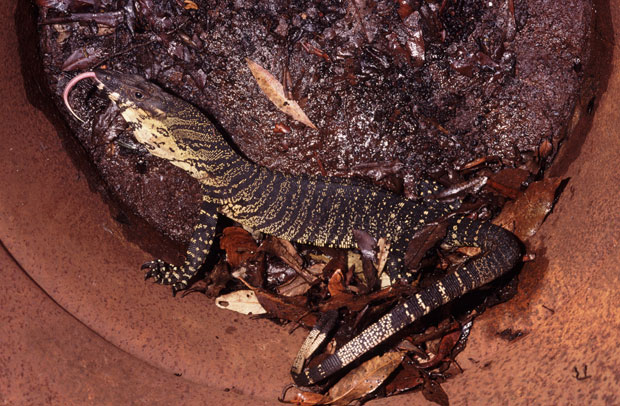
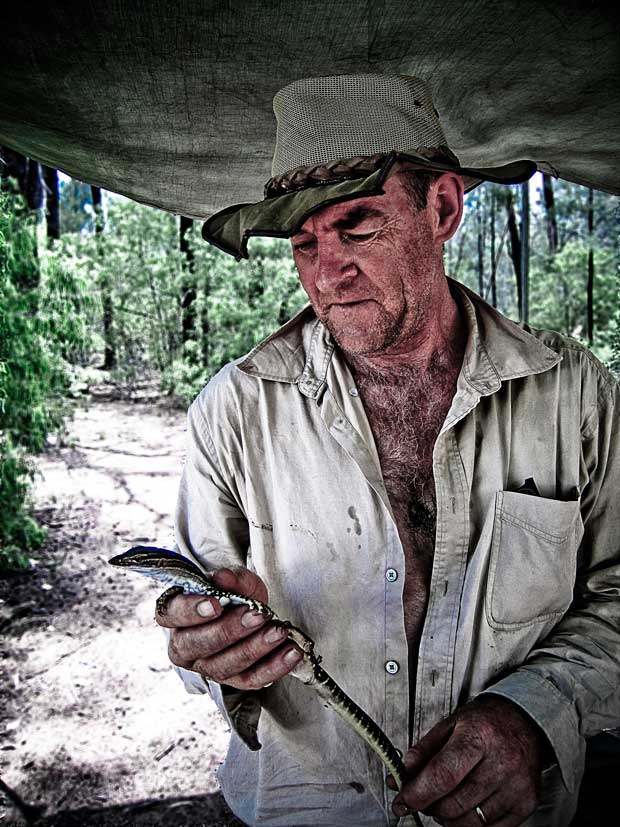

I’ve been researching the indigenous words for many of the animals, plants, vegetation communities and land surface features found in the Murray-Darling River catchment of southern Qld. and northern NSW. On the topic of monitors, the words and the species they indicate are not always clear. I thought I would type up some of the information to see how this compares with present day scientific thinking. I’m hoping some of the experts out there may be able to run through these and validate, clarify, or contradict the info as is relevant. I am particularly interested in the “phases” that they speak of, particularly banded and pink phases as outlined below.
The NSW Kamilaroi (Gamilaraay), Yuwaalaraay, and Yuwaaliyaay words show slight differences between them, but they are for the most part similar, so I have grouped them together here for convenience. They named the common Tree goanna (Varanus varius) yurrandaali “when in its spotted phase” and mangun.gaal when in its “spotted phase”. The Sand goanna (Varanus gouldii) they called dhuullii or biiwii, however the anthropologist and linguist Greenway (1878) places the word dhuulii with the Tree goanna.
To confuse matters they also recognized a “Ground goanna” which is most likely the same as the Sand goanna, as the name again is biiwii. They also recognized a “Small black-spotted” or “Black-headed goanna”, which they sometimes called “Pink goanna” because they say the male turns a dirty pink colour during the mating season. They named this monitor galgarriirr and I have taken it to be the Freckled monitor (Varanus tristus).
Goanna eggs were called gulay.
The Muruwari who roamed the vicinity of Nebine Creek and the Culgoa floodplain to the SE of Cunnamulla in Southern Queensland also recognized a “Small tree goanna” (galgi) which they separated from the common Tree goanna (gugard, or warruy). They called the Sand goanna, (aka Ground goanna and “Grass goanna”) barna, and the Black-headed goanna (aka Black-spotted or Freckled monitor) dirrin. However they apparently also called the Freckled monitor warruy and possibly also galgi. So we can only ponder if their “Small tree goanna” was in all cases the Freckled monitor, or if another species was/is involved?
Sorry, correction for second paragraph above. The Kamilaroi word for Tree goanna should be mangun.gaali and is used for when the monitor "is in its banded phase", that is when it has wide bands of black and yellow on body and tail. Also called Black goanna and Lace monitor.
Ian,
There are four goanna (monitor) species known from the Murray-Darling catchment within south-east Queensland. They are the Lace Monitor Varanus varius, the Yellow-spotted Monitor Varanus panoptes, the Freckled or Black-headed Monitor Varanus tristis and the Sand Goanna or Gould's Monitor Varanus gouldii. All are relatively common reptiles although the Freckled Monitor (your Speckled Monitor) is not as often seen as the others. This is mainly due to its retiring habits and arboreal lifestyle. It will also live in the ceilings of buildings, in rock piles and caves. I once found one tucked up snug in an abandoned Fairy Martin's nest. The Freckled Monitor and the Lace Monitor are both arboreal whereas the other two species are essentially terrestrial although I've seen a Sand Goanna climb a tree when close-pressed by a fox terrier. The Sand Goanna will scuttle into a hole or hollow log when harassed whereas a large Yellow-spotted Monitor will 'stand and deliver' when annoyed; a formidable creature indeed. Varanus panoptes and Varanus gouldii are very hard to separate in the field especially in young individuals. Reports of large Sand Goannas in south-east Queensland are more likely to be of Yellow-spotted Monitors. It is only relatively recently that it has been realised that Varanus panoptes actually extends east as far as the outer suburbs of Brisbane in south-east Queensland. Before this Gould's Monitor/Sand Goanna records could have referred to either this species or the Yellow-spotted Monitor in this area.
In addition there is a colour phase of the Lace Monitor that is fairly common west of the Great Divide in the area concerned although it can be found right through to the coast. This is a heavily banded form known as "Bell's form" of the Lace Monitor. This is only a different colour pattern of this lizard. It does not constitute another species of monitor nor does it represent a subspecies of Varanus varius.
The Freckled Monitor found within the area discussed is actually the subspecies orientalis i.e. Varanus tristis orientalis. This subspecies is widespread and on the coast I have found it as far south as Bauple near Maryborough in south-east Queensland. It appears to be absent from the south-east corner of Queensland but comes in again in the Brigalow Belt around Dalby on the Darling Downs. I've seen it around Lake Broadwater near that town. This subspecies extends west to about Eulo where it is replaced by the nominate species i.e. Varanus tristis tristis. It is here where the other common name for this monitor is more appropriate viz. Black-headed Monitor, as this goanna in this area has a defined black head and neck whereas orientalis has its body pattern and colour extending on to its neck and head. Varanus tristis orientalis is a subspecies and not a colour phase of the Freckled/Black-headed Monitor.
I cannot find any reference to, nor have I any personal experience with a pink 'phase' of any of these or other Australian monitors. I canvassed the opinions of several other herpetological authorities on this, including a friend who has bred many Australian monitor species and published an comprehensive book on the Australian lizards, and none have any knowledge of a pink goanna either as a colour phase or as a breeding colour of any known species.
Regards,
Rod Hobson
Rod, Thank you for the very thorough reply. I was not aware of the existence of Varanus panoptes as I suspect my well-worn yet now outdated Cogger book on “Reptiles and Amphibians” had not made the separation from tristis.
I strongly suspect that the so-called phases may actually be subtle changes in colouration as the reptiles age. Another possibility is that colour changes may have been noted when the reptiles were either in the process of shedding their skin or had just recently shed (i.e. a “dirty” appearance when shedding, turning bright and colourful with new skin).
The colour “pink” does not surprise me, because having studied many Aboriginal languages for the past few years, it does seem that many of the words for colours were frequently applied to multiple colours. For instance, in Kamilaroi we find that the word for dark brown, dark blue, and black are all the same word. The word for light green is the same word as that for brown. Grey and white are also indicated in many cases by the same word. In some languages yellow and red are not differentiated. So it really does not surprise me that the “pink phase” may actually mean “a time when the goanna looks bright and creamy”. The creamy colour under the neck of the Freckled monitor at Isla Gorge in Robert’s photo (above) could be taken as a “dirty pink” (or “muddy cream” colour). Also the spots on the young monitor at Cooloola could be described as “orangey-pink”.
Rod, you may be able to help me further. Is there any relationship between breeding cycles and skin shedding (i.e. does freshly shed skin correspond with breeding time, even in a general or coincidental way)? If so, this could give a reason for the suggestion of a mistaken “colour phase” related to breeding.
Ian
Edit: First paragraph above. I should have said:
…"had not made the separation from gouldii."